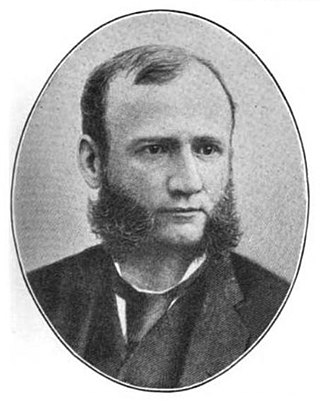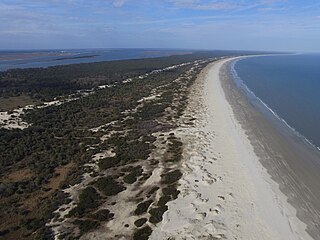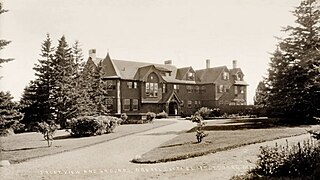
Camden County is a county located in the southeastern corner of the U.S. state of Georgia. According to the 2020 census, its population was 54,768. Its county seat is Woodbine, and the largest city is Kingsland. It is one of the original counties of Georgia, created February 5, 1777. It is the 11th-largest county in the state of Georgia by area, and the 41st-largest by population.

Georgian Court University is a private Roman Catholic university in Lakewood Township, New Jersey. Founded in 1908 by the Sisters of Mercy, the university has more than 1,600 undergraduates and nearly 600 graduate students.

Squash tennis is an American variant of squash, one played with a ball and racquets that are more similar to the equipment used for lawn tennis, and with somewhat different rules. The game offers the complexity of squash and the speed of racquetball.

Thomas Morrison Carnegie was a Scottish-born American industrialist. He was the brother of steel magnate Andrew Carnegie and co-founder of the Edgar Thomson Steel Works.

Peabody & Stearns was a premier architectural firm in the Eastern United States in the late 19th century and early 20th century. Based in Boston, Massachusetts, the firm consisted of Robert Swain Peabody (1845–1917) and John Goddard Stearns Jr. (1843–1917). The firm worked on a variety of designs but is closely associated with shingle style.

Cumberland Island, in the southeastern United States, is the largest of the Sea Islands of Georgia. The long-staple Sea Island cotton was first grown here by a local family, the Millers, who helped Eli Whitney develop the cotton gin. With its unusual range of wildlife, the island has been declared a National Seashore. Little Cumberland Island is connected to the main island by a marsh.

Cumberland Island National Seashore preserves most of Cumberland Island in Camden County, Georgia, the largest of Georgia's Golden Isles. The seashore features beaches and dunes, marshes, and freshwater lakes. The national seashore also preserves and interprets many historic sites and structures.

Brucemore, a park-like, 26-acre (110,000 m2) estate in the heart of Cedar Rapids, Iowa, is the site of a Queen Anne-style mansion, formal gardens, a children's garden, night garden, pond, orchard, and woodland. Built between 1884 and 1886 by Caroline Sinclair, widow of pioneer industrialist T.M. Sinclair, Brucemore has been home to three prominent families who used the estate as a center for culture and the arts. Brucemore, whose name alludes to the Scottish moors of the second owner's ancestral home, is Iowa's only National Trust Historic Site and is preserved by the National Trust for Historic Preservation in co-stewardship with Brucemore, Inc. Under the name of the T.M. Sinclair Mansion, it is listed on the National Register of Historic Places. The mansion has three stories, and contains twenty-one rooms. Distinctive features include a steeply gabled roof, five chimneys, and several turrets.

Elm Court is a former Vanderbilt mansion located on Old Stockbridge Road, straddling the town line between Lenox and Stockbridge, Massachusetts. It is listed on the National Register of Historic Places and until July 2012 was owned and operated as a hotel by descendants of the original owners.
Dungeness is a headland in Kent, England.

Dungeness on Cumberland Island, Georgia, is a ruined mansion that is part of a historic district that was the home of several families significant in American history. The mansion was named after a nearby sandy spit at the southern end of the island, first recorded in a land grant petition in 1765 and almost certainly named after the Dungeness headland, on the south coast of England. The first Dungeness house was the legacy of Revolutionary War hero Nathanael Greene, who had acquired 11,000 acres (45 km2) of island land in 1783 in exchange for a bad debt. In 1800, his widow Catharine Miller built a four-story tabby mansion over a Timucuan shell mound. During the War of 1812 the island was occupied by the British, who used the house as a headquarters.

The Stafford Plantation was a plantation on Cumberland Island in Camden County, on the southeastern coast of Georgia. It was established in the early 19th century by Robert Stafford.

The Battle of Fort Point Peter was a successful attack in early 1815 by a British force on a smaller American force on the Georgia side of the St. Marys River near St. Marys, Georgia. The river was then part of the international border between the United States and British-allied Spanish Florida; it now forms part of the boundary between Georgia and Florida. Occupying coastal Camden County allowed the British to blockade American transportation on the Intracoastal Waterway. The attack on Forts St. Tammany and Peter occurred in January 1815, after the signing of the Treaty of Ghent, which would end the War of 1812, but before the treaty's ratification. The attack occurred at the same time as the siege of Fort St. Philip in Louisiana and was part of the British occupation of St. Marys and Cumberland Island.
This is a list of the National Register of Historic Places listings in Cumberland Island National Seashore.
Duck House, part of the Richards estate, was a historic dwelling and is an archaeological site on Cumberland Island near St. Marys, Georgia. It was added to the National Register of Historic Places on February 13, 1984, and burned down a few years later from a fire started by an illegal camper.

The Drexel Estate, also known as Gripsholm Manor, is a historic summer estate in Islesboro, Maine. Built in 1903 and located on The Bluffs, a point on the east shore of the island community, it is an excellent example of medieval Tudor Revival architecture. It was built for George W. Drexel, son of banker Anthony J. Drexel and a regional innovator in the design and engineering of high-speed power boats. His estate was listed on the National Register of Historic Places in 1985.

Greyfield Inn is a hotel on Cumberland Island in Camden County, Georgia, the only hotel on the island. The inn is a member of Historic Hotels of America, the official program of the National Trust for Historic Preservation. It was opened to the public as an inn in 1962 in a Colonial Revival-style house named Greyfield located on an estate of the same name; it was listed on the National Register of Historic Places in 2003.
The High Point-Half Moon Bluff Historic District, on Cumberland Island near St. Marys, Georgia, United States, is a historic district that was listed on the National Register of Historic Places in 1978. It is located within Cumberland Island National Seashore.

The Copper Beech Farm, formerly the Lauder Greenway Estate, is a 50-acre (20 ha) private property with a French Renaissance mansion in Greenwich, Connecticut. For a time, it was the most expensive home in the history of the United States.

Lucy Carnegie Ricketson Ferguson was a member of the American industrialist Carnegie family who spent much of her life working to conserve Cumberland Island, the largest part of which was declared a national seashore in 1972. A granddaughter of Thomas Carnegie, her family once owned 90 percent of the island.





















